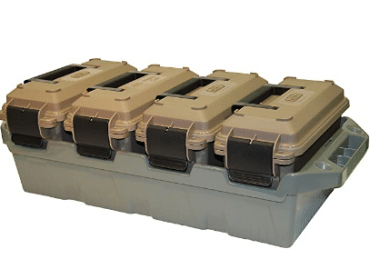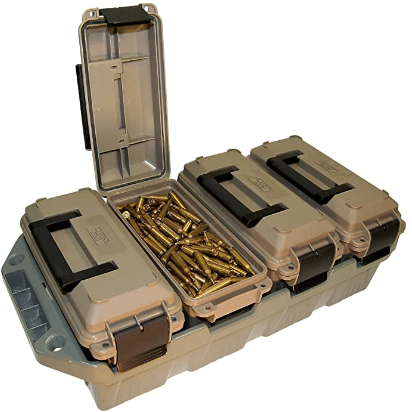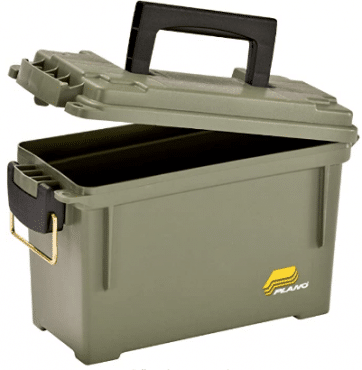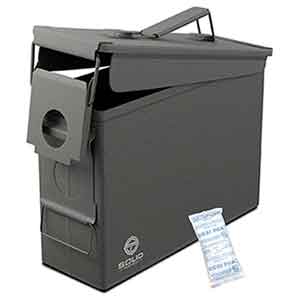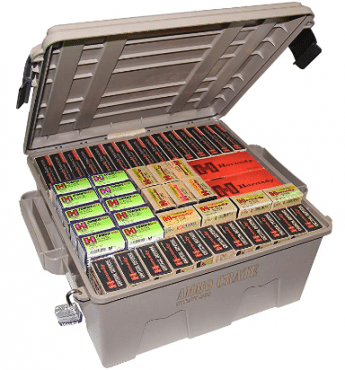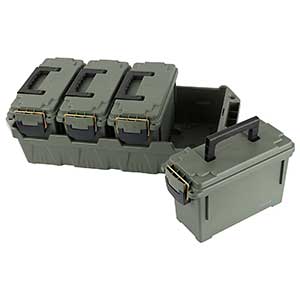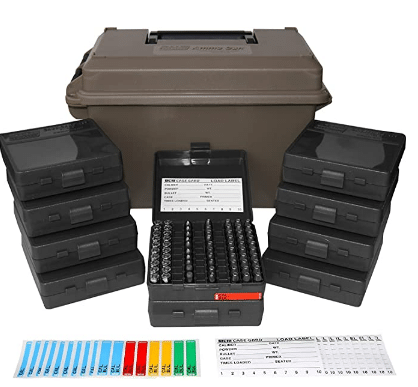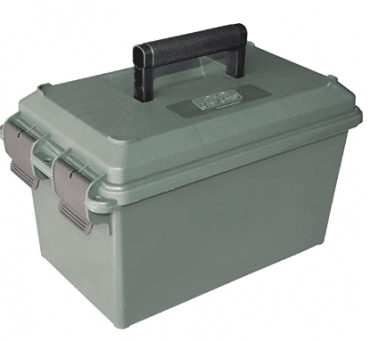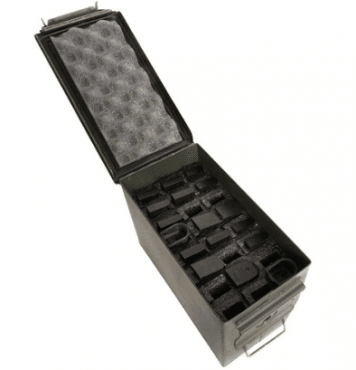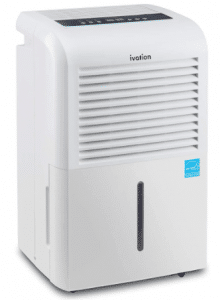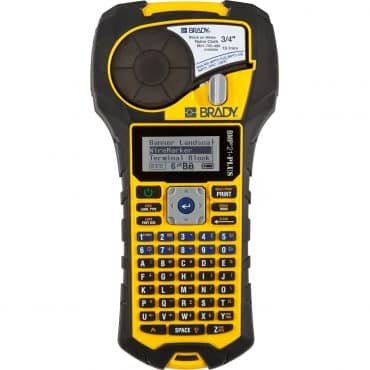A metal ammo can is a guarantee that your ammo stays intact no matter the conditions. This little box will keep your ammunition dry and safe. Its steel design is any moisture-proof, and it is suitable for a big caliber ammo. They are sold as military surplus , so their reputation is concrete. Read on and learn how to get one.
This article has been revised and finalized to reflect the latest information as of 2023
10 Best Ammo Cans On The Market
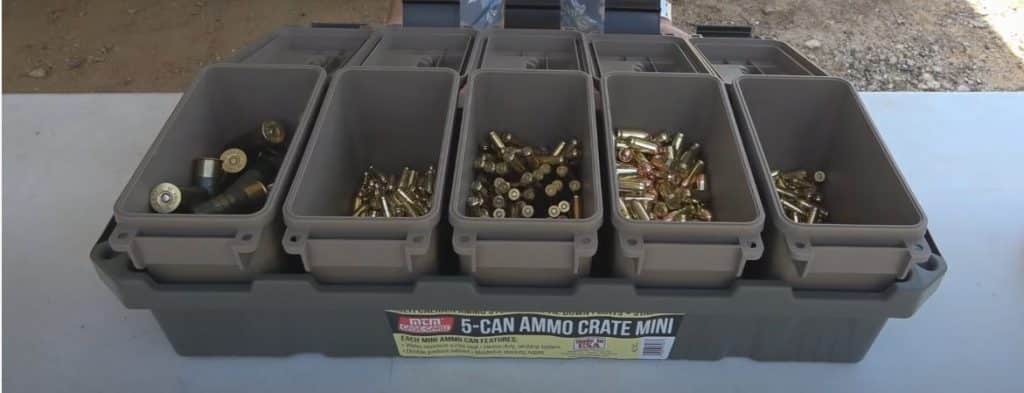
1 – MTM AC4C Ammo Crate System
Sportsman’s Warehouse (Check Price)
- Features: Four tie-down spots for ATV attachment, O-ring seal, stackable design.
- Benefits: Offers a large storage capacity, water-resistant, durable polypropylene construction, and allows for easy transportation.
MTM AC4C ammo crate is a perfect component of a durable setup. What makes it excellent is its enormous capacity of storing several calibers in a systematically arranged and laid-back way. This five-piece set comprises four cans AND an ammo crate fitting every crate, easily taken out.
All of them are 30-caliber — a volume enough to store almost all sorts of ammo.
Add another crate or a special rack and stack your ammunition from the ceiling to the floor with no worries — there are almost no chances to knock them over.
Both cans and ammo crate of rugged polypropylene provide a long-lasting quality; plastic may overpass metal at some point as it will not rust and has no keen edges. There are four places for lorry or ATV transportation, and the tanks include a waterproof O-ring and a reinforced latch system. However, this latch is made of plastic, and its durability maybe not that impressive.
Most people consider this crate one of the top models designed to transfer the necessary ammo to the practice range in a hassle-free mode. All MTM products are made in America in Dayton, Ohio, with all rights reserved.
Now let’s read a customer review and find out how he tested the big number of storable ammo using various calibers:
- “700 rounds of 45 auto was almost it. Maybe another 25rounds.
- 116 rounds of 12ga shells @ 2.75″ long. In plus, it could fit another 10-12.
- 1000 rounds of 9mm and plenty of room for at least another 150.
- I did a test with 5.56 from a buddy. We got to 450 rounds with some space still left.
- This is PER CONTAINER, by the way.”
2 – PLANO Ammunition Field Box Ammo Storage
- Features: Water-resistant O-ring seal, brass-bailed latch, top-access storage lid.
- Benefits: Protects ammo from moisture, easy access to contents, durable construction.
PLANO can be undoubtedly called the most practical and economical of most brands on the market today. Firstly, these plastic ammo can models are stackable, contain a water-resistant O-ring seal, extra durable handle, and a brass lock.
As stated by one reviewer, PLANO Ammo Box boasts the following features:
- “9mm @ 1,000 rounds in the original crates (S&B 115 Gr FMJ… 20 Boxes of 50 rds)
- or 9mm @ 500 rounds of LE in original boxes (Winch. Ranger 147 Gr SXT… 10 boxes of 50 rds)
- or 223 Rem @ 520 rounds in original boxes (Wolf Prem. Gold 55 Gr FMJ… 26 boxes of 20 rds).
When your storage room is limited or wishes to fit it in a gun safe, this ammo can be a good companion.
So, trying to find a cheaper analogy equally good is almost of no sense.
3 – REDNECK Convent Metal Ammo Case Can
Sportsman’s Guide (Check Price)
- Features: Steel construction, airtight rubber gasket seal, collapsible handle.
- Benefits: Durable and long-lasting, protects against moisture and air, easy to carry.
This metal ammo crate is distinguished by its super air and watertight seal, a hinged lid with a locking latch, and a flat-folding handle.
It’s built to last since it’s made of heavy gauge solid steel. The lid includes a rubber gasket that ensures a tight fit to keep water and air out.
It offers three various color designs — classic camo green (.30 caliber or .50 caliber), tan tone (.50 caliber only), or black (.50 caliber only).
There are many product reviews on this model, and here’s what one reviewer outlines:
“I put loose ammunition in this can, and also in plastic ammo crates by MTM and Plano. As the plastic containers had rubber seal around the inside of the lid I supposed they would keep out moisture but when I placed desiccant packs with color-changing beads (from blue when dry to pink when moistured) in all the containers…. The desiccants in the plastic ammo cans turned pink in almost two weeks while the desiccants in Redneck metal box were still blue in the same time.
This is a solid reason the reviewer proceeded with buying more Redneck metal cans instead of plastic ones.
However, such a model’s potential drawback is a tiny hollow decentered space at the bottom of the can, which means the piles may slant.
4 – Solid Tactical 30 Cal Metal Ammo Can
Sportsman’s Guide (Check Price)
- Features: Steel construction, airtight seal, powder-coated finish.
- Benefits: Durable, protects contents from moisture and air, resistant to corrosion.
This 30 Cal Metal Ammo Can is an asset if you want to keep your ammo in more manageable portions without having the cans getting too heavy. Size of them is measured as the following:
- Small size – 13.9 x 8 x 4.4 inches (30 cal)
These ammo cans are a nice trophy, both air- and water-proof, designed with a tight rubber seal and metal latches, hinges, and a compact handle.
Find out the price for such a three-in-one deal now.
5 – MTM Tactical Mag Crate
- Features: Four tie-down spots, stackable design, side-mounted handles.
- Benefits: Ideal for storing magazines, easy to transport, durable polypropylene construction.
This Tactical Mag Crate from MTM makes it easier to store the loaded magazines instead of keeping piles of your ammunition in a huge number of crates and boxes. This crate provides a tight storage area conveniently foam mag inserts suitable for up to 14 magazines.
Its design is simple but rather efficient, having two easy-to-grasp handles, four tie-down points, all stackable.
Keep in mind that this mag crate model can hold .308 mags.
See with your own eyes how MTM Tactical Mag Can works.
6 – MTM ACR8 Ammo Crate Utility Box
Sportsman’s Guide (Check Price)
- Features: O-ring seal, double padlock tabbed, large carry handle.
- Benefits: Water-resistant, secure storage with padlock compatibility, easy to carry.
This gigantic ammo crate provides an even greater storage area for your ammo, shotgun shells, and other stuff.
The reviewers tend to point its quality, reliable design keeping the ammunition “dry and well-organized,” and the fact that it is still manageable to move when filled to the top.
Its stacking capacity allows fitting (60) boxes of Remington green/white box .223 in it with no effort or damage.
This huge ammunition crate is stackable and comprises two solid handles, four tabs, a waterproof O-ring seal, and dual padlocks so you can transport your big ammo like a boss with this ammo crate.
Check out the actual price for this ammo crate or search for other brands on Amazon.com.
7 – Tactical45 4 Pack Plastic Bulk Ammo Storage Containers
- Features: Snap-tight latch, stackable design, translucent body.
- Benefits: Easy identification of contents, secure closure, maximizes storage space.
If you want four-piece ammo can set at a bargain and protect your survival gear, you should definitely check out these four Tactical45 Plastic Ammo Cans and Ammo Carrier Tray.
First of all, they are waterproof and designed neatly with rubber sealed gasket and easy-carry plastic swivel handle plus, you may easily add an extra latch as there are in-built holes to attach a padlock.
These are water-resistant due to their tongue and groove lid design and rubber sealed gasket. Plus, they include ammo case rack tray lets you carry 4 ammo containers at once.
The one complaint is it’s not extremely heavy-duty and not a guarantee to be “airtight” for the long run.
But at this price point, these still may be worthwhile if you’re primarily looking to organize your stash.
8 – SOLID TACTICAL 50 Cal Ammo Can (comprises desiccant pack)
Sportsman’s Guide (Check Price)
- Features: Steel construction, airtight seal, includes a desiccant pack.
- Benefits: Offers enhanced moisture protection, durable, large storage capacity.
This 50 cal ammo can is a totally different air-proof level for your hassle-free stock for your future.
Why is it so? Obviously, due to a solid material: top-quality metal is the most durable companion to your ammo.
Besides, this is a no-risk deal since Solid Tactical‘s customer service provides a Money-back guarantee. Isn’t it a tempting shopping feature?
Mind that metal cans may be heavier than you expect, though. Here’s an extract of a related review by a recent customer: “The crate arrived quickly, and I was surprised at how heavy duty it was,” it requires a little muscle to open the lock.” Heavy but very secure: it has a waterproof seal and several desiccant packs.
This video demonstrates the 50 caliber ammo’s unboxing can by Solid Tactical and reviews its core features (mentioning 30 Cal Ammo Box along with the way).
Follow one of the Solid Tactical links in this chapter to find out more product info and check current offers.
9 – MTM ACC9 Ammo Box Combo (for 1000 rounds)
Sportsman’s Guide (Check Price)
- Features: Designed for 9mm and .380 Auto rounds, slip-top lid, polypropylene construction.
- Benefits: Specific storage solution for 9mm and .380 Auto rounds, protects ammo from dust and moisture.
MTM ACC9 ammo can models boast an advantageous organizing capacity comprising ten 100-round boxes, each fitting into the ammo crate itself.
It has a nifty design and color-coded stickers with four various color options (80 labels overall) and ten helping cards for your ammo description.
Let’s substantiate the description with a customer’s report, though:
“It is an awesome box for 9mm. Worth every penny. It comes with 10 100 Rd cases and one large container that holds all 10. Plus, it provides enough space for one more”.
One huge ammo can for many hassle-free range days and super-easy reloading — isn’t it worth the money?
10 – Previously Issued U.S. G.I. M2A1 Metal 50 Cal Ammo Can (a used one)
- Features: Steel construction, airtight seal, military-grade.
- Benefits: Proven durability given its military use, large storage capacity, robust construction.
If you’re looking for a brand-new sparkling, shining, and flawless ammo can — skip it over as it is not for you!
However, if you want to proudly notice the traces of history on your ammo can as if it’s been in several battles and now boasts some men’s battle scars — you are right to choose this one.
Here is the list of previously used 50 cal ammo cans that the Military Issued. Yes, they may not have avoided rust, scratches, dings, and stuff, but they are more like old fellow soldiers with many backstories to tell.
Let’s see what one of the many customers wrote about them: “I do love the fact that it has been already used by our military before.”
And here’s another message from a customer:
“First of all, this ammo crate is USED MILITARY SURPLUS. If you want a solid steel construction ammo can, this is your ultimate goal. These cans are fantastic and I would not doubt to purchase more. As a personal bonus, my can was marked with 5.56mm on the side, exactly what I want on storing in it.
Purchase this without doubt as it’s the U.S. military surplus 50 caliber ammo can of extremely resilient gauge steel with a rubber gasket (its inside dimensions are 11 by 5.5 by 7).
We all know that moisture is the ammo crates’ enemy, but in this case, it definitely will not pass!
In plus, consider that most of the used models may cost less than $14 99, which is an investment in your budget. Use Amazon.com website and its customer service to shop, or call them directly to guide you through the current prices, shipping options depending on the delivery address, and further details.
Any ammunition owner has wondered about organizing and storing it properly one way or another. No reason to explain why — choosing quality containers from compact ammo boxes, standard ammo cans, huge ammo crates, and so on increases its storing efficiency and safety, prolongs your ammo’s shelf life and generally contributes to accurate household management.
To protect your investment efficiently, you should acquire proper ammo storage: among the core ammo can types, there are two: Metal and Plastic cans. To choose apparently depends on your plans and purposes. Let’s set it out more fully now.
Some Essential Accessories

Stickers / Decals
Check Price Now
After you’ve bought your first ammo can, you should think of adding helping can decals and other essential products.
It will make your life easier by simply naming your ammo’s content so that you do not have to open it and dig through your ammo. It is not only a nice little adding but may play a crucial role in sudden time pressure or an emergency. You know, perfect labeling may save you time and prevent future costly spendings.
Besides, if you want to ensure extra moisture protection, there are many silica gel desiccant packs on the market today. Whether you choose a plastic or a metal crate, those packs will eventually provide an almost 100% anti-moisture seal.
Locking Hardware
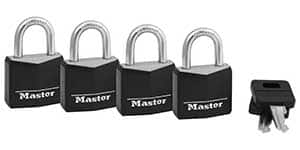
Check Price Now
Adding ammo box locks is a matter of your safety, and it upgrades it to the next level. There are two basic categories to choose from — a lock hardware or a hanging padlock. Navigate through the links to find the product information you personally need.
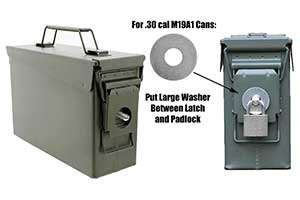
What’s the point, you may say, since a thief may take the whole crate and be gone? But the locks will surely not let your kids or neighbors or anyone unwelcome take your ammo stock.
Foam Inserts
Check Price Now
If you want to see your magazines lying neatly and safely when checking the ammo boxes, we advise you to purchase foam inserts besides.
There are various cutout forms and sorts, and we recommend to start with Case Club M2A1 .50 Cal Foam Insert (or follow the link here to check out more foam insert types).
Expert Insights into Ammo Cans:
The Evolution of Ammo Cans: Ammo cans have evolved from simple wooden crates used in World War I to the robust metal and plastic containers we see today. Their primary purpose has always been to protect ammunition from environmental factors, ensuring that soldiers and enthusiasts have reliable ammo when they need it.
Material Matters: While many purists prefer the traditional metal ammo cans, modern plastic variants offer significant advantages. They are often lighter, resistant to rust, and can be more affordable. However, metal cans, especially those made of steel, provide a level of ruggedness and durability that’s hard to match. They can withstand rough handling, making them ideal for rugged terrains and extreme conditions.
Sealing the Deal: One of the most critical features of an ammo can is its seal. A high-quality rubber gasket ensures that moisture, dust, and other contaminants stay out. This is crucial for ammunition, as moisture can lead to corrosion, rendering the ammo unsafe or unreliable. When choosing an ammo can, always check the quality and condition of the seal.
Storage and Organization: Modern ammo cans, especially those from brands like MTM and Solid Tactical, often come with features that make organization easier. Dividers, trays, or compartments can help sort different calibers or types of ammo. This is especially useful for enthusiasts who have a diverse collection of ammunition.
Safety and Security: While ammo cans are designed to be sturdy, it’s essential to consider safety. Some cans come with double padlock tabs, allowing users to secure their ammunition. This is especially crucial if there are children in the household or if the ammo is stored in a location with multiple users.
The Importance of Desiccants: Ammo cans like the SOLID TACTICAL 50 Cal that come with desiccant packs offer an added layer of protection against moisture. Desiccants absorb moisture, ensuring the inside of the can remains dry. This is an invaluable feature, especially in humid environments.
Understanding Ammo Storage Needs: Different users have different needs. A hunter might prioritize portability and ruggedness, while a competitive shooter might look for cans that offer easy organization. Understanding the end-user’s needs is crucial when choosing the right ammo can.
Enhanced Ammo Can Buying Guide:
1. Purpose of the Ammo Can:
- Short-Term Storage: If you’re looking for a can to transport ammo to the range and back, you might prioritize portability and ease of access.
- Long-Term Storage: For storing ammo for extended periods, focus on cans with robust seals, desiccant packs, and durable construction.
2. Material:
- Metal (Steel or Aluminum): Offers durability and can withstand rough handling. Ideal for rugged terrains and extreme conditions.
- Plastic/Polypropylene: Lightweight, resistant to rust, and often more affordable. Suitable for indoor storage and light outdoor use.
3. Seal Quality:
- A high-quality seal ensures protection against moisture, dust, and other contaminants. Always check the seal’s condition and quality.
4. Size and Capacity:
- Consider the volume of ammo you plan to store. Ammo cans come in various sizes, from 30 Cal to 50 Cal and even larger. Ensure the can meets your storage needs.
5. Portability:
- Look for features like collapsible handles or ergonomic designs that make transportation easier.
6. Security Features:
- Some ammo cans offer double padlock tabs, allowing users to secure their ammunition. This is crucial for safety and preventing unauthorized access.
7. Additional Features:
- Stackability: Some cans are designed to be stackable, maximizing storage space.
- Dividers/Compartments: Useful for organizing different calibers or types of ammo.
- Desiccant Packs: Absorb moisture, ensuring the inside of the can remains dry.
8. Brand Reputation:
- Consider brands known for quality and durability. User reviews and expert recommendations can be invaluable.
9. Price:
- While it’s essential to get value for money, don’t compromise on crucial features for a lower price. Sometimes, investing a bit more can ensure longevity and reliability.
Additional Sections:
A Brief History of Ammo Cans:
Origins: The concept of a dedicated container for ammunition isn’t new. As early as the days of black powder and muskets, military forces recognized the need to keep their powder and shot dry and safe. However, the ammo can, as we recognize it today, has its roots in the early 20th century.
World War I: The Great War saw a massive increase in the production and use of small arms ammunition. Initially, ammo was shipped in wooden crates, but these were bulky, heavy, and not entirely moisture-proof. The need for a more durable and portable solution was evident.
World War II – The Birth of the Modern Ammo Can: The Second World War brought about the metal ammo can most are familiar with. Made primarily from steel, these cans featured a removable lid with a rubber gasket, ensuring a watertight seal. The design was simple, robust, and effective. The U.S. military introduced the M2A1 ammo can, designed for .50 caliber ammunition, and the smaller M19A1 for .30 caliber rounds. These designs have remained largely unchanged and are still in use today.
Post-War Era: After the war, the vast surplus of military equipment, including ammo cans, found its way into civilian hands. Hunters, outdoorsmen, and shooting enthusiasts quickly recognized the value of these rugged containers. They were not only used for ammo but also for storing tools, first aid supplies, and other essentials.
Modern Innovations: While the traditional steel ammo can remains popular, the latter half of the 20th century saw the introduction of plastic variants. These offered a lighter, rust-proof alternative to their metal counterparts. Modern ammo cans also come with features like stackable designs, dividers, and even built-in locks.
Cultural Impact: The ammo can has become an iconic piece of military surplus. It’s recognized worldwide and has been featured in countless movies, TV shows, and video games. Beyond its practical uses, it’s also become a symbol of ruggedness and reliability.
Maintenance and Care:
Maintenance and Care of Ammo Cans:
Regular Inspection:
- Seals: Over time, the rubber gasket that ensures a watertight seal can degrade. Regularly inspect the seal for any signs of wear, cracks, or damage. If the seal appears compromised, consider replacing it to maintain the can’s integrity.
- Latches and Hinges: These are moving parts that can become stiff or rusty. Ensure they operate smoothly and apply a small amount of lubricant if necessary.
Cleaning:
- Exterior: Wipe down the exterior of the ammo can with a damp cloth to remove dirt, dust, and grime. For metal cans, if there’s any sign of rust, use a rust remover or fine steel wool to clean the affected area.
- Interior: Ensure the inside of the can is free from dirt and moisture. If the can has been exposed to damp conditions, wipe the interior with a dry cloth and let it air out. Using desiccant packs can help absorb any residual moisture.
Storage:
- Environment: Store ammo cans in a cool, dry place. Avoid exposing them to direct sunlight for extended periods, as UV rays can degrade plastic cans and the rubber seals on metal cans.
- Stacking: Most modern ammo cans are designed to be stackable. However, ensure that the lids are securely closed to prevent any accidental spills.
Rust Prevention (for metal cans):
- Paint: If the original paint on a metal ammo can starts to chip or wear off, consider repainting it. This not only gives the can a fresh look but also provides an additional layer of protection against rust.
- Desiccants: Placing desiccant packs inside the can help absorb moisture, reducing the risk of rust from the inside.
Upgrades and Modifications:
- Replacement Parts: Over time, parts like handles, latches, or seals might need replacement. Many manufacturers or military surplus stores offer replacement parts.
- DIY Modifications: Some enthusiasts modify their ammo cans by adding dividers, foam padding, or even mounting hardware for easier transportation.
Safety Precautions:
- Locks: If the ammo can is used to store live ammunition, especially in households with children, consider using a padlock or a locking mechanism to prevent unauthorized access.
- Labeling: Clearly label the contents of the ammo can, especially if you have multiple cans with different types of ammunition or gear.
Safety Tips:
- Temperature Control: Ammunition is sensitive to extreme temperatures. Store ammo cans in a location where temperatures remain relatively stable, avoiding areas like attics where it can get excessively hot or basements where it can be damp.
- Away from Flammables: Ensure that ammo cans are stored away from flammable materials or sources of ignition. The propellants in ammunition can ignite if exposed to open flames.
Child Safety:
- Locks: If you have children or unauthorized persons in your household, always lock your ammo cans. Many modern cans come with padlock tabs, allowing for added security.
- Education: Teach children about the dangers of ammunition and the importance of not handling it without adult supervision.
Transportation:
- Secure Placement: When transporting ammo cans, especially in vehicles, ensure they are securely placed to prevent them from moving around. This not only prevents potential damage to the can but also ensures safety in case of sudden stops or accidents.
- Legal Considerations: Before transporting ammunition, especially across state lines, familiarize yourself with local and federal regulations. Some jurisdictions have specific rules about how ammunition should be transported.
Does Ammunition Have an Expiration Date?
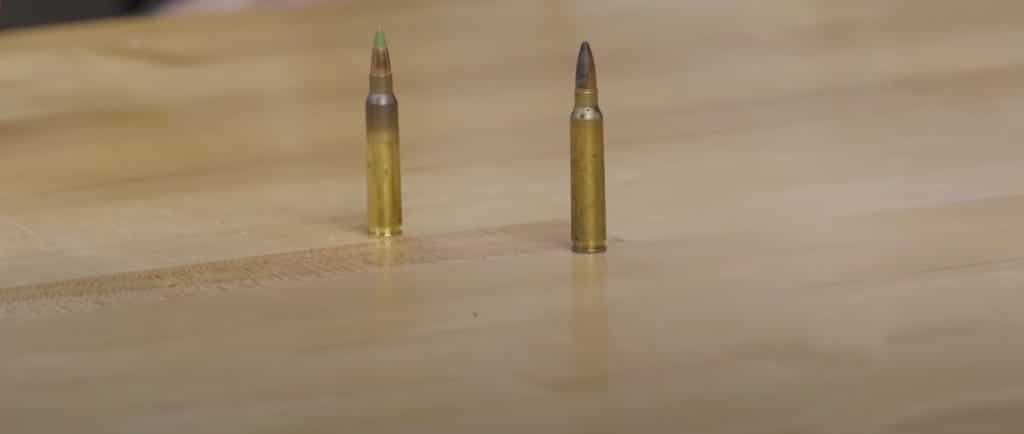
When we talk about firearm items and ammo storage, we use the concept of a useful shelf life, which is no myth and can be extended or cut short by long-term storage conditions. The key point is that unlike foodstuffs, you can keep your ammo for decades and even generations.
Of course, it all depends on the type of ammo products you own, as there are essential differences for storing various kinds of gunshot gear. If you are an experienced prepper, you might have noticed a considerable shortage of ammo on the open market; thus, the question of long-term storage is up-to-date as never before. Therefore if you take our advice and follow the instruction precisely, your ammunition will probably outlive several generations.
Discover the essential gear and tips that we enrolled in our survivalist checklist.
If you are new here and stuck with Q as the question, here are a few basic recommendations that say:
- If you’re buying your ammunition to store for the long term – it is advisable to acquire a metal can.
- In case you need several cans to help with transportation to and from the range – plastic cans are more than enough.
Which of these two materials is the winner? It is you who decides, but as you know, metal has proved its reliability through time – however, its weight may be a problem. Plastic cans overtake metal containers in weight and easy-carrying though they may deform quicker, especially in extreme conditions.
If you’re still pondering which type to choose to carry your handguns’ mags, these two videos will provide you with the necessary guidelines. Otherwise, you may skip over this content and turn over the page to read about the ten best Ammo Can models using our heading shortcut key. Just double-tap to read brief content).
We would give at least 4.5 out of 5 stars to every model in the following list, so do not hesitate to select any of those.
Check out the customer reviews comparing Military Surplus Metal Ammo Cans and MTM Plastic Ammo Cans on the videos page.
Vintage Ammo Against Modern Ammo
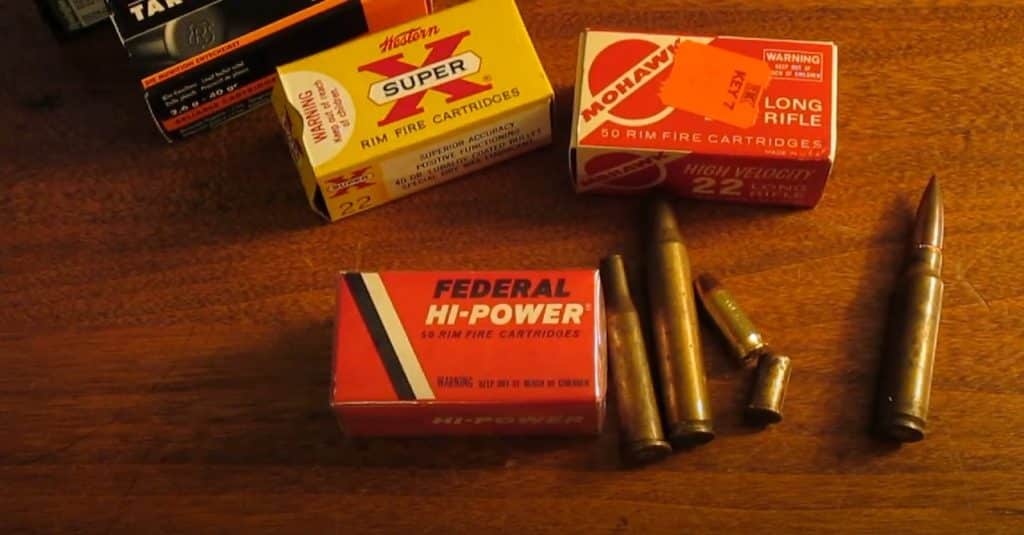
People have always been interested in protecting their homes, and some even manage to combine work and pleasure. We talk about preppers who possess older collections of ammunition. The 1930s put into circulation smokeless powder that replaced highly explosive black powder. Let us consider this period a border to distinguish modern gear from older firearms and ammunition.
Ensure you preserve health and safety as these shotgun ammo containers become either useless or extremely dangerous and explode at the moment of firing. Modern smokeless powder and black gun powder can almost equally compete and are used for different loaders. Be careful and attentive, choosing your options as the price of ignorance and carelessness is too high.
Hi-tech materials, new modeling approaches, and contemporary ways of execution introduce a lot of improvement into the latter-day ammo characteristics that positively influence the ammo box content’s useful life. It brings relief to those who have been storing ammo for the last thirty years. One needs only to adhere to ammo and gun storage conditions to prevent risks and blank shots.
If you want to find out how to store ammo properly, the best ammunition containers, and where to look for dependable products and services, we encourage you to follow our comprehensive survey.
No matter how bad the scenario gets, our survivalist list will help you be ready for any potential danger.

DOWNLOAD FREE
EMERGENCY PREPARATION GUIDE
Store Your Ammunition Properly: Our to Do List
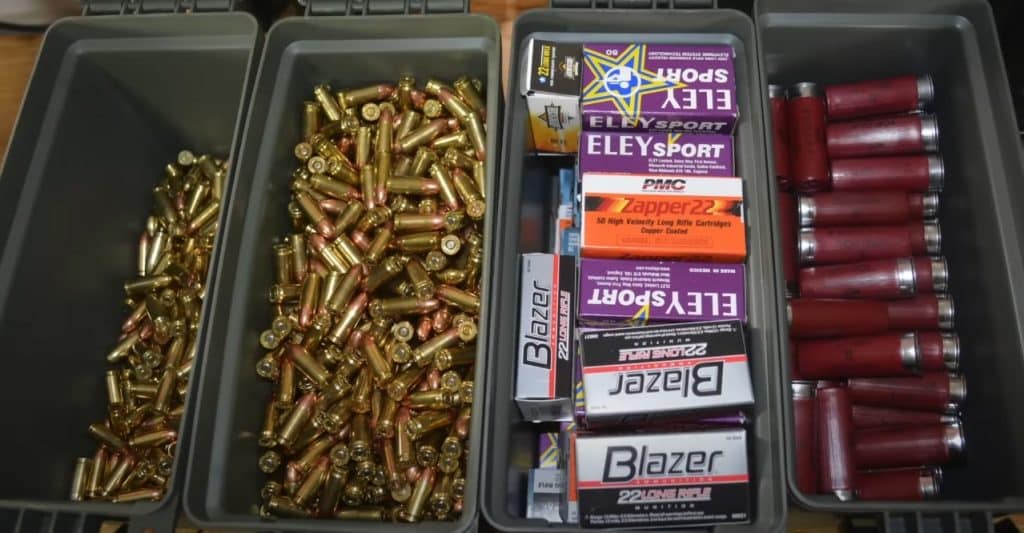
No matter how experienced or new you are to this business. We claim that storing ammo is not more complicated than running food storage. All you need to do is follow several essential rules, and we are going to unveil some tips. There are several guidelines for preparing an ammo storage space, narrowed down to three main laws — the place must be dry, cool, and dark.
Let us examine in depth each metrics that can stretch your ammunition shelf life for decades and then some.
Store Your Ammo in a Dry Place

Humidity is a number one enemy to ammunition and if you are going to create a reserve, double-check the moisture levels of the storage. Most people don’t have a stand-alone location to store ammunition, so basements become the evident place for storing an ammo box. By a twist of fate, these areas have the highest humidity degree in the entire house. Being located below the ground level, basements often get drowned, and if not, accumulation of dampness from the environment is still a big concern. Moisture degrades the metal, and even little rust is a big sign that your ammo is under threat. Given that ammunition’s main surface material is metal, moisture is the number one thing to avoid. Once the process starts, it’s hard to bypass consequences.
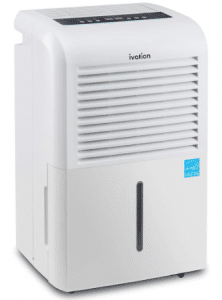
- Never keep exposed ammo and ammo storage container items on the floor. In case of flood, this area will be the one to face the water attack, and your ammo cans will get ruined.
- It’s a great idea to utilize racks, shelves, and cabinets to get firearms, cartridges, and ammo boxes as distant from the ground as possible, so in case of water leaks, your reserves will remain safe.
- Buy a dehumidifier unit to pump out moisture from the air constantly. The drier the environment is, the better. There are some great products on the market that combine high-quality levels and reasonable pricing.
About Dehumidifiers and Desiccants — Moisture Protection
Desiccant packs combined with dehumidifiers guarantee moisture-free storage, which is the first rule to follow if you want to prolong your gun products and ammo’s useful life. Desiccants use special silica particles that catch the moisture and leave the air inside an ammo container 100 percent dry. It results in the absence of rust and corrosion, which can degrade your cartridges and ammo metal parts.
Other types of desiccants have different algorithms for absorbing moisture. These rechargeable devices have some great advantages. Our team reviews the following models as these gear possess several outstanding options ensuring dry and safe storage.
- This tactical hydrosorbent has a wide coverage of up to three feet in every direction. One device can maintain several ammo cans free of moisture. In our reviews, you will find much valuable advice, and another one sounds as follows — use universal devices of one style if you want to avoid headaches concerning upgrade. Remember, it’s not a mobile application, and you won’t have a chance to download the new version just by filling out your name, email address, or else.
- One of the greatest options is that one can use a 300 degrees oven to make the desiccant work again. Put them into the oven for three hours, and your desiccant box is reloaded.
- Color indicators show when the time has come to recharge the dryer.
- This desiccant material doesn’t contain cobalt chloride, which is super-hazardous and causes cancer. The items below are safe to use.
What’s the best option for long-term waterproof ammo storage? Watch the video with a comparison between metal and plastic ammo cans tested underwater.
Make sure you are aware of the best preppers tools that can save your life in case of an unfavorable scenario. Consider our survivalists’ checklist.
Labeling is Essential — Choosing a Tool

While we are dealing with military-style activities and products, maintaining discipline and accuracy is essential. So if you want to reduce your efforts while looking for this or that item or gun, labeling will be a great solution.
The contemporary market offers a great number of office equipment, among which you will find such an indispensable tool as a quality labeler. Ammo storage is not a matter of a month or a year. In most cases, you will maintain the process for decades, and we are pretty sure that hardly any memory capacities can afford to hold this kind of information for years. And it’s unnecessary with labeling.
Labels are vital in emergency cases. If you don’t want to open each ammo crate or ammo box every time you need particular equipment, it’s vital to bring self-discipline.
With progressive yet affordable labelers, this process will bring a lot of fun and satisfaction, too. You can mark food containers, cans with other gear types and indicate inherent areas like gas and water sections. Make use of our survival gear list and expand your prepper knowledge.
Once you master labeling your ammunition or military surplus cans, make sure to revise your ammo crate regularly. Make it a rule of thumb to open every storage box and check your ammunition, accessories, and desiccant substances like silica gel every half a year. We promise that such thorough stock control will be of great advantage in case of emergency or upheaval.
Store Your Ammo in a Dark Place
UV exposure is another enemy of your ammunition and firing gear. UV rays are capable of deteriorating almost anything when kept exposed to the environment. Even stainless steel will suffer in outdoor conditions; therefore, if you want to expand your ammo useful shelf and leave it for long-term storage, you must exclude the UV factor.
In terms of UV reduction, a basement without windows or a storage closet makes a perfect combo of budget-saving measures and efficiency. These places sustain dark conditions, while your ammo storage containers double the safety.
Store Your Ammo in a Cool Place

If you are eager to prolong your ammo’s useful life, you need to consider extreme temperature exposure as seriously as moisture. Extreme heat, as well as freeze-up extreme temperatures, will jeopardize your gun products and ammunition. The reason is that temperature swings provoke humidity, which, as we have discussed above, is corrosive to metals.
Constant swings of extreme temperatures can depend on the area you live in. Thus in some regions, season temperature changes from hundred degrees Fahrenheit during summer months to below zero temperatures in winters. It is a matter of big concern. Your ammo can withstand such temperature cycles for some seasons in a row but will be 100 percent compromised in the long-term run. It makes garages and unheated places worthless storage areas.
What is a dependable location for ammo storage?
- A professional ammunition magazine or a root cellar is an excellent variant. However, few properties can afford such rooms.
- Any dry place below 10 ten feet will make perfect gun and ammo storage. Ground temperatures are more constant than air ones and maintain a narrower temperature range equal to 20-25 degrees Fahrenheit. It makes basements an excellent location from this point of view.
A Step-by-Step Ammo Storage Guide
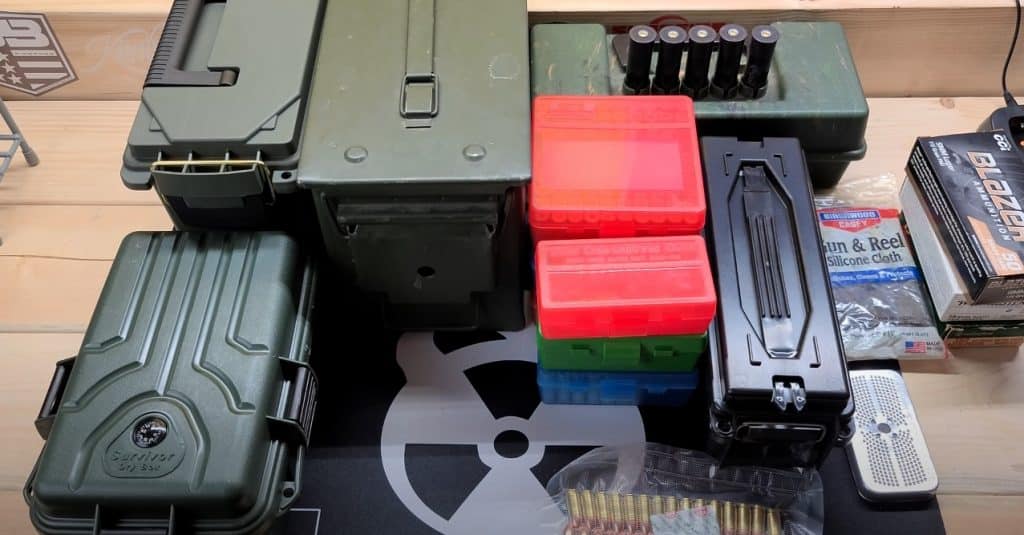
We conclude our reviews with this step-by-step algorithm – easy and effective:
- Choose the best desiccant option for storing your ammo. Try to render your advice and remember that temperature swings are corruptive and degrade gun equipment and ammo. Avoid unheated areas of your house, and your vehicle as these places maintain moisture.
- Obtain top-quality boxes and ammo containers. A solid, dependable ammo container may be a little pricey, but it’s the case when quality comes with costs. In our reviews, we rely on users’ feedback and product information claimed by the manufacturers. Thus you can trust our recommendations.
- Use desiccants in every container, ammo crate, and ammo box. Recharge fresh materials to avoid moisture.
- Check your ammo every five or six months. Organize the process and label your ammo items to have fast access in case of emergency and danger. Watch these video reviews of how to arrange your ammo risk-free maintenance.
- Last but not least, among our guidelines is the general safety of your ammo. It will be helpful to store your ammo locked in solid gun safes. There are numerous gun safes reviews on the market, so one will indeed find the solution that suits best.
In Conclusion
Are you still hesitating to store your ammo gear in special ammo boxes?
Having an ammo stockpile is a life-long investment as you do not usually have to renew the box each year, and you do purchase it once for a long while. Measure the expenses and compare them with your personal defense cost today, tomorrow, and in some distant future. It’s straightforward: you protect your investment, and it protects you in response.
We hope you have found our advice valuable. You are welcome to use our guidelines to prolong the life of your ammo and keep your ammunition dry, safe, and dependable. Our reviews were created to tip off a shooter or a prepper, no matter how professional one is. As we have already mentioned, a case of caution is never too much!
Frequently Asked Questions – FAQ
Can the storage box be buried safely underground?
Usually, such boxes and crates can be buried underground; for example, by using the time-tested metal Military can or certain MTM can models, you may not worry about anything buried inside it — from ammunition to valuable personal belongings. Some crate models can even be buried underwater if they’re 100% waterproof.
What are the inside dimensions of this box?
Inside dimensions surely vary depending on the model and brand. For instance, the used Military G.I. M2A1 BMG 50 cal ammo cans have inside dimensions of 11 by 5.5 by 7. Choose the volume corresponding to your caliber and stuff preferences.
The best ammo can is…?
The best is the reliable and durable one, a box which is relatively easy to carry even when filled to the lid (no matter if it is plastic or metal can), and the one suitable personally for you — test any of the above-mentioned models and leave us a message in the comments.

